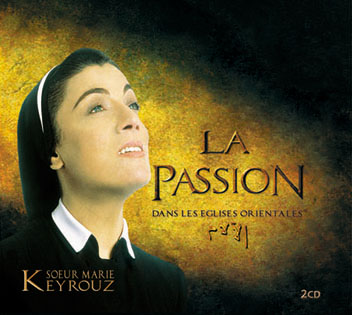Passion Of The Christ
| 25,00 ą |
-
Man Haza
0:33
Sister Marie Keyrouz – Man Haza
-
Hallelouya - Ma Abha
00:37
Sister Marie Keyrouz– Hallelouya - Ma Abha
-
Ghanni R Rab
00:23
Sister Marie Keyrouz – Ghanni R Rab
-
Innani Uchahid
00:40
Sister Marie Keyrouz – Innani Uchahid
-
Abu Dushto
00:43
Sister Marie Keyrouz – Abu Dushto
-
Gnen Abdeh
00:30
Sister Marie Keyrouz – Gnen Abdeh
-
Al Yawma Sabba
01:09
Sister Marie Keyrouz – Al Yawma Sabba
-
Iqbalni
01:07
Sister Marie Keyrouz – Iqbalni
-
Ya Chaabi
00:39
Sister Marie Keyrouz – Ya Chaabi
-
Emar Qayso
00:43
Sister Marie Keyrouz – Emar Qayso
-
Al Yaum Ulica
00:38
Sister Marie Keyrouz – Al Yaum Ulica
-
Ayyuha R Rabou
00:50
Sister Marie Keyrouz – Ayyuha R Rabou
-
Rabbi L Mazbouh
00:48
Sister Marie Keyrouz – Rabbi L Mazbouh
-
Anal Ummul Hazina
00:39
Sister Marie Keyrouz – Anal Ummul Hazina
-
ITahadat
01:04
Sister Marie Keyrouz – Tahadat
-
Nicodeme
00:43
Sister Marie Keyrouz – Nicodeme
-
Tishbouhto L Morio
00:58
Sister Marie Keyrouz – Tishbouhto L Morio
-
Moubarakun
00:32
Sister Marie Keyrouz – Moubarakun
-
Christos Anesti
00:48
Sister Marie Keyrouz – Christos Anesti
-
Mariam
00:17
Sister Marie Keyrouz – Mariam
-
Yawmu L Qiyama
00:40
Sister Marie Keyrouz – Yawmu L Qiyama
-
Qama Hayyan
00:43
Sister Marie Keyrouz – Qama Hayyan
-
Inna-l-Malak
00:55
Sister Marie Keyrouz – Inna-l-Malak
-
Halleluia - Resurection
00:24
Sister Marie Keyrouz – Halleluia - Resurection
-
Qamallah
01:03
Sister Marie Keyrouz – Qamallah
PASSION OF THE CHRIST IN EASTERN CHURCHES.
This double Album presents a pilgrimage between the stations of the Passion of Christ, from Palm Sunday to the Resurrection, with chants of the main rites from the Eastern Churches stemming from
This poetry was written by the Sacred Fathers of the Eastern, Greek, Syrian, and Arabian Churches, such as Jean Chrysostome, Basil the Great, Ephraim and Romanos the Melodious, who invite us, every day during Holy Week, to meditate on one theme concerning the image of faith and the mysteries of the story of the Resurrection†: Joseph who was sold by his brother, the Last Judgement, the Sterile Fig Tree, Marie Madeleine or the Repentant Sinner, the Betrayal and Despair of Judas, Jesus Washing the Feet of his Disciples, †the Crucifixion of Christ, and finally ends with hymns concerning the Resurrection.
The musical characteristics of these hymns are closely linked to the theology of the populations who believed, and to their social history. Songs about Aramean, Syrian, and Maronite rites have been transmitted orally ever since the first centuries of Christianity. These sacred chants have a monastic and austere character whilst being inspired by the population. They are completely monophony, and almost always strophic and syllabic. They are sung in Aramean and Arabian languages. Melodies are always constructed by a joint movement and are often limited to a fourth or a third with a rhythm that can be quite varied.
Concerning Byzantine Melkite chants, they also stem from the first†
This is a noble, very sophisticated and melodious†A Cappella†chant; its composition follows the eight mode principle and demands an extremely large range and technique.
Musical accompaniment following the tradition of the†
However, as centuries went by, musical accompaniment took a larger place in the interpretation of liturgical chants in the Syrian and Maronite Churches, and instruments such as the†Ud, the†Qan?n, theNay, the†Kaman, and Drums were used.
Improvisation is very important is these repertories and is used to express what can not be expressed by simple notes. Music is born from a conviction in faith, it serves the text and displays the intimate faith of the cantor; in the style that has long been used in sung sermons, we see the theology of the Passion incarnated, human emotion when confronted by suffering, rendered by vocal capacities.
A theological and musical pilgrimage from Suffering to Hope.
Sister Marie Keyrouz
- ←
- 1
- →
